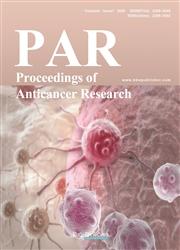Performance Evaluation of Combined Detection of Serum CEA, CYFRA21-1, CA125, and NSE in Patients with Lung Cancer by Fluorescence Flow Cytometry
引用次数: 0
Abstract
Objective: To investigate the effect of combined detection of serum carcinoembryonic antigen (CEA), cytokeratin 19 fragment (CYFRA21-1), cancer antigen 125 (CA125), and neuron-specific enolase (NSE) in patients with lung cancer by fluorescence flow cytometry. Methods: From August 2019 to July 2022, 200 patients with lung cancer diagnosed by pathology in our hospital were retrospectively analyzed. 2 mL venous blood was collected in a fasting state and centrifuged to separate the serum (containing human chorionic gonadotropin antibody [anti-hCG antibody], hepatitis B surface antibody [anti-HBs antibody], and CEA). Results: The sensitivities of CEA and CYFRA21-1 detected via enzyme-linked immunosorbent assay (ELISA) were 100%, and the detection limits were 0.5 ng/mL and 0.1 ng/mL, respectively; the sensitivities of CA125 and NSE detected via flow cytometry were 100%, and the detection limits were 10 U/mL and 2 ng/mL, respectively. Compared with ELISA, the sensitivities of CA125 and NSE detected via flow cytometry were higher. When the concentration of CEA was 10–40 ng/mL, the sensitivities of the three markers CYFRA21-1, CA125, and NSE showed no significant changes (P > 0.05); when the concentration of CEA was 40–80 ng/mL, the sensitivity of CEA significantly decreased (P < 0.01), but the sensitivities of the three markers CYFRA21-1, CA125, and NSE showed no significant changes (P > 0.05); when the concentration of CEA was 80–200 ng/mL, the sensitivities of all four markers showed no significant changes (P > 0.05). Conclusion: Compared with the double-antibody sandwich ELISA, fluorescence flow cytometry has certain advantages, including high sensitivity, good precision, short detection time, low sample usage, and low medical cost; thus, it is worthy of clinical promotion.荧光流式细胞术联合检测癌症患者血清CEA、CYFRA21-1、CA125和NSE的疗效评价
目的:探讨荧光流式细胞术联合检测癌症患者血清癌胚抗原(CEA)、细胞角蛋白19片段(CYFRA21-1)、癌症抗原125(CA125)和神经元特异性烯醇化酶(NSE)的效果。方法:回顾性分析2019年8月至2022年7月我院经病理诊断的200例癌症患者的临床资料。在禁食状态下收集2mL静脉血并离心以分离血清(含有人绒毛膜促性腺激素抗体[抗hCG抗体]、乙型肝炎表面抗体[抗-HBs抗体]和CEA)。结果:酶联免疫吸附试验(ELISA)检测CEA和CYFRA21-1的敏感性为100%,检测限分别为0.5ng/mL和0.1ng/mL;流式细胞仪检测CA125和NSE的敏感性为100%,检测限分别为10U/mL和2ng/mL。流式细胞仪检测CA125和NSE的敏感性高于ELISA。当CEA浓度为10–40 ng/mL时,三种标志物CYFRA21-1、CA125和NSE的敏感性没有显著变化(P>0.05);当CEA浓度为40–80 ng/mL时,CEA的敏感性显著降低(P<0.01),但三种标志物CYFRA21-1、CA125和NSE的敏感性没有显著变化(P>0.05);结论:与双抗体夹心ELISA相比,荧光流式细胞仪具有灵敏度高、精密度好、检测时间短、样品用量少、医疗费用低等优点;值得临床推广。
本文章由计算机程序翻译,如有差异,请以英文原文为准。
求助全文
约1分钟内获得全文
求助全文

 求助内容:
求助内容: 应助结果提醒方式:
应助结果提醒方式:


